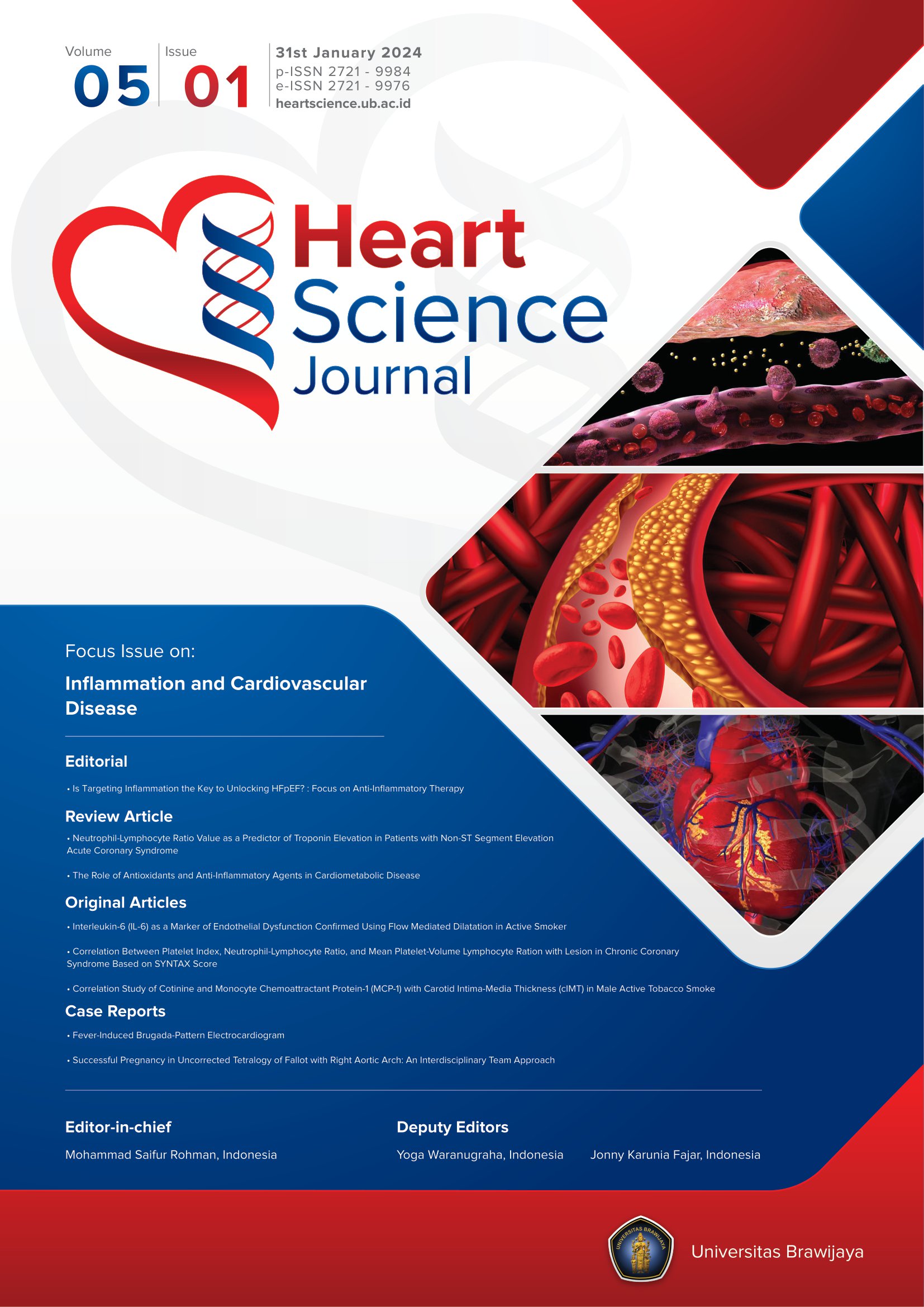Myocardial Bridging, A Neglected Anomaly in Acute Coronary Syndrom: Case Report
Abstract
ABSTRACT
Background: Myocardial Bridging (MB) is an anomaly characterized by an intra-myocardial route of a segment of one of the major coronary arteries. Functional myocardial bridging is less commonly observed on angiography (0.5–16%) and can range from 4 to 80 mm in length. This case report elaborates about a case of a symptomatic MB occurrence in a patient manifesting as an acute coronary syndrome.
Case presentation: A 66 years old female presented to ER with a typical angina gradually increasing since 1 week ago. Associated symptoms were episodic syncope, dyspnea, and dyspepsia. physical examination reveals, vital signs are within normal limits. The cardio-pulmonary examination was unremarkable. Electrocardiogram (ECG) showed inverted T waves on V1-V4, cardiac biomarker enzymes were not increased, chest X-ray revealed an enlarged heart, echocardiography showed a left ventricular hypertrophy (LVH) with normal left ventricle ejection fraction (LVEF). Nitrate, aspirin, and P2Y12 inhibitor were then administered in the ER, and the patient was then transferred to catheterization lab. CT-Angiography showed a MB in the middle left anterior descending (LAD), the patient was then treated with bisoprolol as a maintenance therapy.
Conclusion: MB, if presenting symptomatically, especially as an acute coronary syndrome (ACS), may become lifeŧhreatening if not recognized and treated appropriately. Flow normalization and symptom management in such circumstances are best achieved through revascularisation via percutaneous coronary intervention (PCI) and drug therapy by using beta-blocker.
Keywords: Acute coronary syndrome, case report, epicardial artery, myocardial bridging
Keywords
Full Text:
PDFReferences
REFERENCES
Ripa C, Cristina Melatini M, Olivieri F, Antonicelli R. Myocardial bridging: A “forgotten” cause of acute coronary syndrome-a case report. Int J Angiol. 2007;16(3):115–8.
Yuan SM. Myocardial bridging. Brazilian J Cardiovasc Surg. 2016;31(1):60–2.
He X, Ahmed Z, Liu X, Xu C, Zeng H. Recurrent attack of acute myocardial infarction complicated with ventricular fibrillation due to coronary vasospasm within a myocardial bridge: A case report. BMC Cardiovasc Disord. 2020;20(1):1–5.
Möhlenkamp, Stefan & Hort, Waldemar & Ge, Junbo & Erbel R. Update on myocardial bridging. Circulation. 2002;106(2616):22.
Corban MT, Hung OY, Eshtehardi P, Rasoul-Arzrumly E, McDaniel M, Mekonnen G, et al. Myocardial bridging: Contemporary understanding of pathophysiology with implications for diagnostic and therapeutic strategies. J Am Coll Cardiol. 2014;63(22):2346–55.
Tarantini G, Migliore F, Cademartiri F, Fraccaro C, Iliceto S. Left Anterior Descending Artery Myocardial Bridging: A Clinical Approach. J Am Coll Cardiol. 2016;68(25):2887–99.
Lozano Í, Baz JA, López Palop R, Pinar E, Picó F, Valdés M, et al. Long-term prognosis of patients with myocardial bridge and angiographic milking of the left anterior descending coronary artery. Rev Esp Cardiol. 2002;55(4):359–64.
Lee MS, Chen CH. Myocardial Bridging: An Up-to-Date Review. J Invasive Cardiol. 2015;27(11):521–8.
Nakaura T, Nagayoshi Y, Awai K, Utsunomiya D, Kawano H, Ogawa H, et al. Myocardial bridging is associated with coronary atherosclerosis in the segment proximal to the site of bridging. J Cardiol [Internet]. 2014;63(2):134–9. Available from: http://dx.doi.org/10.1016/j.jjcc.2013.07.005
Chatzizisis YS, Giannoglou GD. Myocardial bridges are free from atherosclerosis: Overview of the underlying mechanisms. Can J Cardiol. 2009;25(4):219–22.
Corban MT, Hung OY, Eshtehardi P, Rasoul-Arzrumly E, McDaniel M, Mekonnen G, et al. Myocardial Bridging. J Am Coll Cardiol [Internet]. 2014 Jun;63(22):2346–55. Available from: https://linkinghub.elsevier.com/retrieve/pii/S0022202X15370834
Krasniqi X, Çitaku H. Anomalous Origin of Coronary Arteries. In: Vascular Biology - Selection of Mechanisms and Clinical Applications [Internet]. IntechOpen; 2020. Available from: https://www.intechopen.com/books/vascular-biology-selection-of-mechanisms-and-clinical-applications/anomalous-origin-of-coronary-arteries
Sarkar M, Niranjan N, Banyal P. Mechanisms of hypoxemia. Lung India [Internet]. 2017;34(1):47. Available from: http://www.lungindia.com/text.asp?2017/34/1/47/197116
Ambesh P, Sharma D, Kapoor A, Hess A-T, Shetty V, Hollander G, et al. Unusual Sign from an Unusual Cause: Wellens’ Syndrome due to Myocardial Bridging. Case Reports Cardiol. 2018;2018:1–3.
Pederçole GL, Oliveira MDP, Moritz MA, Cury RBB, Caixeta A. Myocardial bridging mimicking Wellens’ syndrome. J Xiangya Med. 2020;5:6–6.
Goldberger AL, Goldberger ZD, Shvilkin A. Myocardial Ischemia and Infarction, Part II. Goldberger’s Clin Electrocardiogr. 2018;92–103.
Bourassa MG, Butnaru A, Lespérance J, Tardif JC. Symptomatic myocardial bridges: Overview of ischemic mechanisms and current diagnostic and treatment strategies. J Am Coll Cardiol. 2003;41(3):351–9.
Toth PP. Subclinical atherosclerosis: What it is, what it means and what we can do about it. Int J Clin Pract. 2008;62(8):1246–54.
Ge J. New signs characteristic of myocardial bridging demonstrated by intracoronary ultrasound and Doppler. Eur Heart J [Internet]. 2000 Dec;20(23):1707–16. Available from: https://academic.oup.com/eurheartj/article-lookup/doi/10.1053/euhj.1999.1661
DOI: https://doi.org/10.21776/ub.hsj.2022.003.02.6
Refbacks
- There are currently no refbacks.
Copyright (c) 2022 Gita Pangestu Hapsari, Gabriel Riadhy Tanok Harmany, Daniel Dionisius Sianipar, Adityo Nugroho Kalandoro, A. Sari Sri Mumpuni

This work is licensed under a Creative Commons Attribution 4.0 International License.









